-
For one last regular post before summer, I thought I'd talk about sports.
Baseball:
You know that baseball is very big in Japan and Korea. China formed a professional league in 2002. According to www.chinatoday.com, "Founded in 2002 and continuing to grow, the China Baseball League (CBL) is China's professional league for the sport, with seven teams around the country. ... For the time being, football and basketball remain the most popular Western sports, but baseball is quickly on the rise."
Chinese baseball has been around as a school sport and goes back to 1863 when the Shanghai Baseball Club was established. Thus, baseball was a big club sport and there were university teams and tournaments. It just wasn't on a professional level yet. Our own Major League Baseball took an interest in Chinese baseball and in November 2003, U.S. baseball officials signed an agreement with China to exchange coaches, provide equipment and develop baseball in schools. The United States State Department has also funded a program to send Chinese baseball players and coaches to the United States for training. (China Today)
Little League is strong in Asia. I remember Taiwan having a good teams and we all remember Japan being in the Little League World Series. Korea too has strong contenders. Now China is coming on as well and in 2016 sent their Guangzhous girls team to play in the World Series tournament in Williamsport, PA.
China is taking the first step forward in the pandemic world - well, more specifically Taiwan. I have been reading Deadspin and I also found info on CBS Sports. Taiwan’s Chinese Professional Baseball League opened 2020 first. They do only have 4 teams, and they are not on par with Japanese or the US players, but it was a start. They started with empty stands and cheerleaders, but are starting to let some fans attend games.
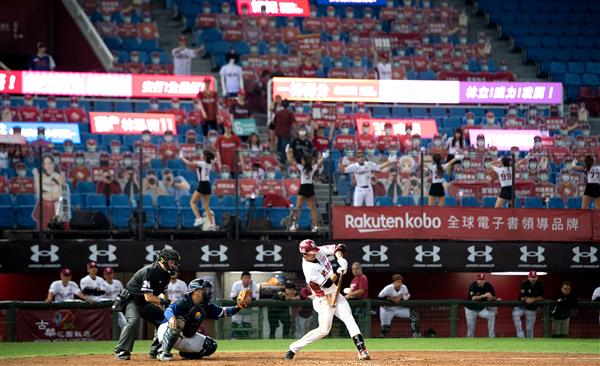 Taiwan started with cheerleaders and no fans.
Taiwan started with cheerleaders and no fans.The Korean Baseball Organization professional league started up last month. The league home page Korea Baseball, shows that unlike in the US, Korea has its teams named for corporations and not the city they are in. I see teams such as the Kia Tigers, the Samsung Lions, nd the LG Twins. It looks like they have 10 teams. If you haven't seen Korean baseball in the news this month, it has been a bit amusing to see on TV. Again, with no fans in the stands, the Koreans decided to try to make it look good. They set up dolls and stuffed animals in the seats and piped in cheering LOL. Now the Koreans are known to really do it up. They use all manner of special effects on a normal basis. In starting back up, they decided not to go all high tech with the first pitch. They had a young boy to throw the first pitch, BUT, for safety sake, the boy was in a giant blow up baseball and rolled the ball towards homeplate as he walked. The batter looked all lined up to let loose, but as the boy approached, he gently tapped the bubble with the bat.
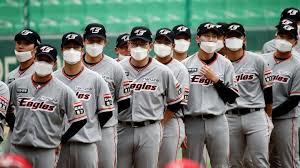
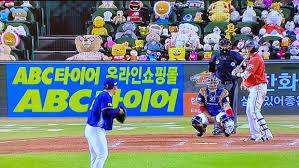
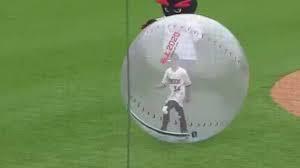 Korean Baseball League starts back up. The ceremonial first pitch was a boy in a bubble.
Korean Baseball League starts back up. The ceremonial first pitch was a boy in a bubble.Baseball is huge in Japan. I can tell you it is a very big deal, even before Japan sent players to our Major League. One of my friends had a nephew on a team and sent me a golf towel. Another friend talks about the Yamiuri Giants. The Nippon Baseball League has now also started up play, June 19. without fans in the stands. I am sure this is a great relief to Japanese baseball fans who have probably really missing cheering for their teams.
Japan has 12 teams and for 2020 will play a season abbreviated from 143 regular season games down to 120. The All-Star game, and any inter-league play has been cancelled for this year.
Japan too names its teams for sponsoring companies. We would call the Yamiuri Giants the Tokyo Giants. There is a Hanshin team....if you every watch a train going through the Hudson Valley and see the cargo containers on it, I bet you will see Hanshin crates. If you see a picture of a large ocean going container ship, or the big shipping terminal in Elizabeth, NJ, you are guarenteed to see a lot of Hanshin containers. If you hear about a team called the Ham Fighters, it is not all one name like the Red Sox, Ham is the company and the team are called the Fighters.
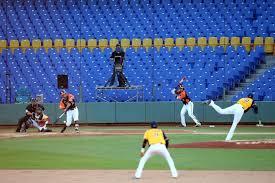 Japanese baseball restarts post COVID-19
Japanese baseball restarts post COVID-19According to the Culture Trip, there are 7 ways Japanese baseball is different than in the US.
1) There are only 12 teams in the NPB. MLB has 30.
2) High school baseball is just as popular, if not more, than pro.
3) Players rarely change teams.
4) Japan broke the color barrier 10 years before the US. Although Japan tends to be a largely homogeneous society, it never segregated its leagues.In 1936 a black pitcher from the US, James Bonner, signed wtih the newly formed Tokyo team.
5) No heckling! While there are certainly chants and cheer songs, heckling the other team is frowned upon. Love it!
6) It is hard to beat the stadium atmosphere in Japan. There are rally balloons, crazy mascots, and yes, beer girls who carry a keg in a backpack and pour right at the seats.
7) NBP games can end in a tie. There is an extra inning limit of 12 innings during the regular season and 15 in the playoffs. No all nighters like we have had in the USA. For the record, the longest MLB game, played between the Brewers and the White Sox in 1984, lasted 25 innings and took two days to finish because they paused play at the 18th inning and came back the next day!
Ok, so that's baseball. What else is played in China, Korea, and Japan?
According to ISPO.com, running, fitness, badminton, table tennis, basketball, winter sports, and soccer. Soccer is the on the level it is in Europe, but it is growing in popularity. Badminton and table tennis are among the most popular sports and the Chinese dominate here in the international and professional levels. Well we KNOW they are great with table tennis. It is amazing to believe that players manage to keep the ball on the table the way it is flying back and forth. I dare you to hold the paddle the way they do. I played a lot as a kid because my parents put a table in our basement. I remember THEN trying to hold a paddle the way the Chinese do - not easy.
If you have watched the Olympics, you have seen China really coming on in figure skating and gymnastics. Recent Olympics showed China fielding large teams. You have learned in Global the history of Mainland China vs. Taiwan. This was an issue at the Olympics with Taiwan being told they couldn't call themselves China. They now must compete as Chinese Taipai, even though they call themselves the Republic of China, ROC. They are not allowed to use their own national flag. They were using an Olympic Flag. Instead of their National Anthem when a team member won gold, they played their National Flag Anthem. It is a political mess. ROC even sued the International Olympic Committee when the IOC told them they could not compete as the Republic of China with their own flag.
Meanwhile, Mainland China has hosted the Olympics, and will again. Following up on the Bejing Summer Olympics in 2008, the 2022 Winter Olympics are being held in Beijing. Yes, WINTER. I said winter sports were gaining in popularity with China fields fine figure skaters, skiiers, etc. If you have been watching Travelogue China, there was a show that included going skiing in China. There were nearly 650 ski resorts in China as of 2016.
Running has become popular. In 2016 there were over one million marathon running in China. According to ISPO sports companies find runners in China are an especially interesting target group. The runners are substantially younger than those in Europe, and they spend more money on their hobby. The main group of runners in China are between 36 and 45 years old, followed by the 25 and 35 year olds.
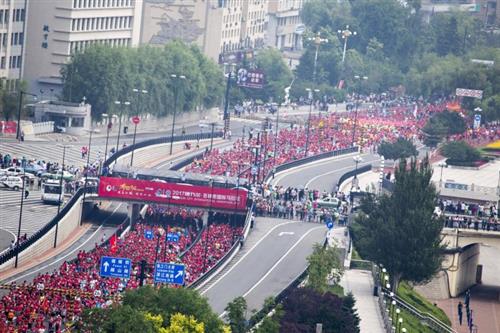 Jilin Marathon
Jilin MarathonThere is a Chinese Basketball Association. There is also a Women's Chinese Basketball Association, as well as school teams. Yao Ming is not the only Chinese player to come to America to play. In addition, other Chinese players who competed in the CBA in the early stages of their careers before cmoing to the NBA are Wang Zhizhi, Mengke Bateer, Yi Jianlian, Sun Yue, and Zhou Qi. They have allowed a small number of foreign players to play on Chinese teams. The CBA resumed play post-COVID-19 on June 19. They had 16 rounds of the regular season left and would only play in two cities. Team players and staff would be held to abide by epidemic prevention laws. Not all foreign players may have been able to come back to play.
Korea was interesting coming to compete in the Olympics. There were separate teams, North and South, of course. Trying to find some coexistance, the teams marched together as one team in 2000, 2004, and 2006, but competed separately. With the Pyeongchang, South Korea Winter Games in 2018 the two Koreas took the interesting step of fielding a combined ladies hockey team. North Korea competed independently in alpine skiing, figure skating, short track speed skating, and cross- country skiing. North Korea sent 22 athletes to Pyeongchang, but they also sent 400 supportes, led by their ceremonial head of state Kim Yong-nam (he holds the largely ceremonial position of the president of the Presidium of the Supreme People's Assembly. Kim Jon Un is obviously the real leader). They sent cheerleaders, taekwondo practitioners and an orchestra. When I think of the South Koreans in the Olympics I definitely think of short track speed skating - they are excellent at this sport.
According to Top End Sports, the biggest contribution Korea has made to sports is Tae Kwon Do. It is the most recognizable Korean sport and has some of the most beautiful moves in the world of martial arts. However, Korea is getting westernized in its sports tastes. They enjoy soccer and baseball, as we said above. Their more traditional sports include bull fighting, wrestling, and kite flying! Kite flying, according to Top End, is considered a sport for most of East Asia. South Koreans today though are getting into soccer. They have made the FIFA World Cup semis in 2002 and 2010 fter qualifying for every World Cup since 1986. Other teams sports gaining popularity include basketball, golf, and rugby. I must smile - does North Korea like basketball? OR ddi Kim Jom Un just find Dennis Rodman amusing that he invited him to visit?
Japan works hard and plays hard. Golf is well liked. The best thing we could do for some of our past visitors from our sister city of Niimi was to take them golfing because greens fees are very expensive in Japan. They of course like baseball and soccer. Skiing is very popular. Tokyo had the most amazing thing - a tall building that was actually an indoor ski slope! According to USA Today, Japan's first snow dome has an unusual history. During the late 1980s, Japanese manufacturer N.K.K. Steel expressed concern about the company's ability to remain competitive in the shipbuilding industry. As is typical in Japanese business practices, the company had guaranteed their employees lifetime employment. Management maximized their workers building and welding talents, and erected a snow dome in 1993. It was called SSAW, an acronym for Summer, Spring, Autumn, Winter. Although it closed in 2002, SSAW inspired other Japanese manufacturers to create their own indoor snow parks. Now there are a bunch. They also invented an artificial snow. USA Today tells us in 1987,Masahisa Otsuka, a former Sanyo refrigeration engineer combined a packet of granules in a beaker of water and created a solution of super-absorbent polymers. Freezing the solution resulted in artificial snow, an important innovation for the snow sport industry. Otsuka is president of Snova, a company that builds artificial indoor snowboard parks near Tokyo. Unlike real snow, Snova snow will not melt or ice up.
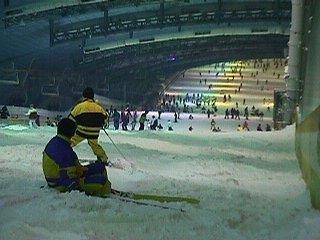 Indoor skiing in Japan
Indoor skiing in JapanNaturally the martial arts are popular in Japan, but a truly Japanese sport is sumo. It is a type of wrestling, but with different rules. Hisgo tells us that the match begins when both wrestlers put both hands on the ground, and ends when one player is pushed out of the ring or any part of their body other than the soles of their feet touches the ground. It is a highly esteemed and respected sport. Top wrestlers have celebrity status. Sumo wrestling has religious elements as its origins are founded in Shinto tradition. However, it's not as strongly tied to Shinto as it once was. There are strict rules to follow on diet and dress.
On Journeys in Japan one of the weekly hosts showed young boys at a sumo school. What is amazing is what these people EAT! We recognize sumo wrestlers as being quite heavy. Well it takes a high calorie diet to get there. I was shocked to see how much they eat!
 Sumo wrestling
Sumo wrestling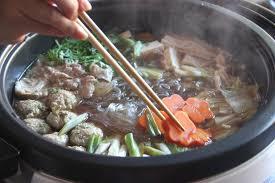 Chanko nabe, or Sumo Stew, is a robust hot pot filled with all kinds of vegetables and tons of protein in a rich dashi and chicken broth.
Chanko nabe, or Sumo Stew, is a robust hot pot filled with all kinds of vegetables and tons of protein in a rich dashi and chicken broth. Traditional sports include sumo, Kendo, Yabusame, judo, Aikido, and karate. Kendo is "theh way of the sword". It is similar to fencing based on samurai sword-based training. Participants use wooden sword, not real metal.
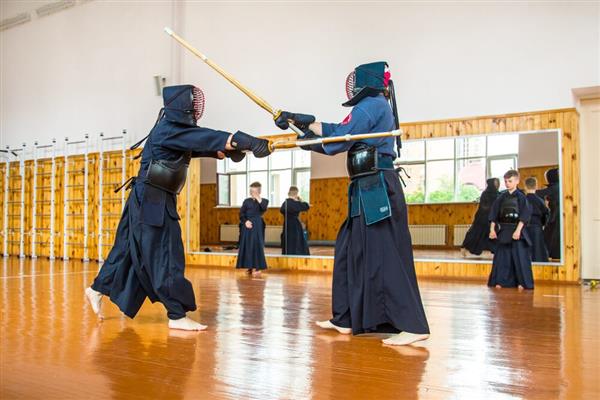 Kendo
KendoYabusame is Japanese archery on horseback. Remember the Mongols invented this? According to Hisgo, being able to shoot a bow and arrow on horseback was done in samurai battles, and was a highly esteemed skill to have. During the time of samurai battles, samurais would aim to hit their target while going full speed on their horse. In modern times. the aim of yabusame as a sport and martial art is usually to be able hit targets while moving. Demonstrations are held in shrines and temples, and sometimes during festivals.
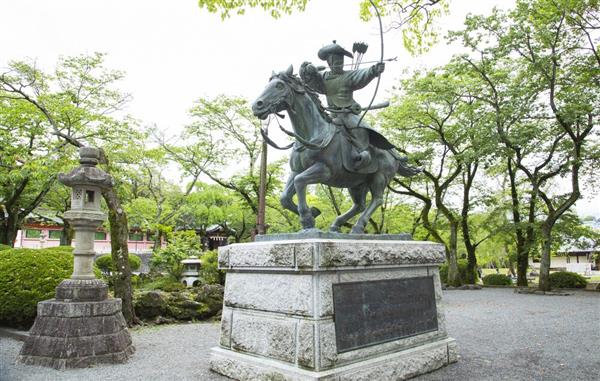 Yabusame statue
Yabusame statueAll About Japan says that the 8 most popular soprts in Japan (from lowest to highest ranking) are pro wrestling, boxing, auto racing, golf, sumo, tennis, soccer, and baseball. Pro wrestling is not the fake sideshow it is in the US. There is more athleticism because many wrestlers studied a martial art. Pro Wrestling is called Puroresu. If you sound this out slowly, you can hear pro wrestling. It is an English word being forced into the Japanese language.
Boxing was introduced to Japan by Commodore Perry's crew in 1854. The All-Japan Prfefssional Kento Assocation formed in 1931 and became the Japan Pro Boxing Association in 2000. Boxers aren't really encouraged to box on an international level.
All About Japan tells us:
"Competitive auto racing has existed in Japan since the 1920s, but it wasn't until the Tamagawa Speedway was opened in 1936 that the sport had a permanent, dedicated track. Soichiro Honda, who would later go on to found the eponymous car company, was one of the early competitors at the new track, while newly formed Nissan competed with its own factory team.
After forming his company, Honda went on to open the Suzuka International Racing Course, better known as the Suzuka Circut, in 1962. The track has hosted a numerous major world championship events, most notably Formula One. Not to be outdone, Mitsubishi also opened a racecourse, the Fuji Speedway, in the early 1960s (now owned by Toyota). Almost all of the biggest races in Japan happened at one of these two tracks—though there are more than 20 auto racing tracks in total around Japan."
All About Japan also talks about tennis:
"It's believed that tennis first arrived in Japan in 1878, when five courts were constructed in Yokohama's Yamate Park for use by foreigners. In the same year, George A. Leland was invited to introduce Wetern-style physical education to Japan, and it's generally believed that his input led to tennis becoming widely taught across the nation. However, the expense of procuring materials for standard tennis balls led to the development of "soft tennis," which uses a flexible, all-rubber ball. By 1886, soft tennis was the standard form of the sport played in Japan, and it is still taught in public schools across the country to this day.
Tennis has taken a prominent place in Japanese culture. It was in tennis that Japan won its very first Olympic medals, both claimed by Ichiya Kumagai at the 1920 Antwerp Olympics. Japan's Emperor Akihito met Empress Michiko on a tennis court in the resort town of Karuizawa in 1957. The Prince of Tennis manga series has sold over 50 million copies. And since becoming the only male Japanese tennis player to ever be ranked in the top 10 in singles tennis, since 2015 Kei Nishikori has single-handedly put booster jets on the sport's popularity."As for soccer, long before soccer came along there was an ancient kick ball called cuju that developed in China and spread to Korea and Japan. Japan called it kemari. Of course soccer came along and Japan got involved in the 1920s. They fielded a team at the 1036 Olympics in Berlin. A national league was organized in 1965. Soccer stay semi-pro until 1992 when the Japan Professional Football League was formed with 9 teams. Now there are 18 professional soccer clubs in Japan. There is a ladies national team. It was less popular, but in 2011 the Nadeshiko Japan team beat the USA at the FIFA Women's World Cup Final.
When I was in Japan, we played baseball one afternoon. I saw folks playing badminton in the gym at school. And oh, Mr. Paley would be happy - one elementary school we visited had a lineup of unicycles! I was tempted to try it, but my hosts were concerned that I would fall LOL. The other biggie in Niimi? Paragliding. If you go to the Osa neighborhood of Niimi (our original, smaller sister city, now merged into Niimi) you can go jump off the mountain!! There is a national paragliding competition here! If you are really good, you can stay aloft for 30min. I always say I want to go jumpoff Osayama (Mount Osa) LOL! You lay your chute out behind you, run down the slope, and lift off. There are numerous places to paraglide around Japan, and Osa may not pop up in the top 10, but it is, of course, my favorite.
So that is sports in China, Korea, and Japan. There are traditional sports, as well as transplants from the West. Baseball is the biggy for have loud and excited fans. They have put their own stamp on baseball with high tech displays, cheerleaders, and fans that do not heckle the other team. There is definite loyalty to your team, both for fans and players. All three areas have made their mark on the Olympic and World competitions, getting involved in sports liek figure skating and gymnastics. One thing is for sure, folks there take sports very seriously and play hard!
This is my last regular post for the school year. I will, as promised, occasionally post something if I see something of interest. I wish the year had ended differently for us. I truly hope that by Spring 2021 we will be in a better place and perhaps be able to have our Korean Dinner and go to Mitsuwa and hopefully the 2021-22 school year will be totally normal. I miss our time together because you are a great group and I have been honored to help you form this club. Be well, stay safe! Have a great summer!
Hugs,
Mrs. S
Select a School...

